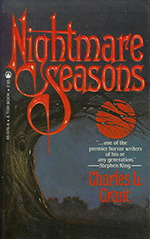
![]() verkisto
verkisto
7/26/2016
![]()
It's been a while since I've read a short story collection that wasn't by Neil Gaiman or Stephen King, but when I realized The Long Night of the Grave was the last Oxrun Station novel, I figured it would be a good time to go ahead and read the Oxrun Station collections. There are four of them, each with four interrelated stories, and Nightmare Seasons is the first of them. In this case, the four stories are each centered on one season, and each story is set ten years apart from the previous one. Surrounding these stories is a vignette to tie them together, though it doesn't carry the importance of the stories themselves.
Thou Need Not Fear My Kisses, Love, the 1930 Spring story, is a supernatural story of obsession and murder. Obsession stories are easy to come by, and usually done a lot better than this (which could partly be due to the brevity of the story; the obsession doesn't really have enough time to get convincing), and the supernatural element is a little cheesy. The story is still full of Grant-isms, but his trademark slow build-up seems to be more a hindrance than a benefit here. Reducing the story to a quarter of its length lessens the impact of an intentional build-up of suspense.
Strangely, this doesn't hold true for Now There Comes a Darker Day, the 1940 Summer story. Here, Grant tells a slow, casual story of a mysterious woman and the death that follows her, and from start to finish, the tension and atmosphere grows until something as innocuous as a rainstorm portends something significant. In the case of this story, the brevity enhances the story, as if it had been drawn out any further, the events would have been strained, and the story forced.
Night's Swift Dragons, the 1950 Autumn story, feels like it was Grant's first attempt at Raven, a book that came later in his career. In it, a group of people is isolated in a restaurant while something begins picking them off; in this novella, a group of people is locked inside a post office while a motorcycle gang with sinister motives waits for them outside. The story was eerie and effective, but then in the last couple of pages, Grant had to go and tack on an ending that came out of nowhere.
The last story, The Color of Joy, the 1960 Winter story, follows in the theme of obsession and stalking, though from a different perspective as the other three stories. Here, instead of the stalker being potentially harmful to the stalkee, the stalker is a threat to those surrounding the stalkee. It's not a new twist by any means, but Grant still tells his tale in such a way as to make it unique.
My appreciation of the individual stories depends on whether or not I was able to read the stories uninterrupted, which suggests that these stories might be better read all in one sitting. I think interrupting the story damages its potential, since the stories slowly creep higher into a sense of dread and inevitability. The whole book doesn't have to be read in one sitting, but it helps to be able to read each story without distraction. Under those circumstances, the stories work very well.